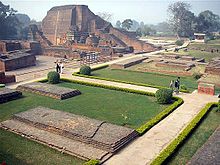
Back تراجع البوذية في شبه القارة الهندية Arabic ভারতীয় উপমহাদেশে বৌদ্ধধর্মের অবনতি Bengali/Bangla Déclin du bouddhisme en Inde French भारत में बौद्ध धर्म का पतन Hindi Kemunduran Buddhisme di anak benua India ID Declino del buddismo in India Italian インドにおける仏教の衰退 Japanese การเสื่อมถอยของศาสนาพุทธในอนุทวีปอินเดีย Thai Suy tàn của Phật giáo ở tiểu lục địa Ấn Độ Vietnamese 佛教在印度的衰落 Chinese

| Part of a series on |
| Buddhism |
|---|
 |
Buddhism, which originated in India, gradually dwindled starting in the 4th-6th century CE, and was replaced by Hinduism approximately the 12th century,[2][3] in a centuries-long process.[4] Lack of appeal among the rural masses, who instead embraced Brahmanical Hinduism formed in the Hindu synthesis, and dwindling financial support from trading communities and royal elites, were major factors in the decline of Buddhism.[5]
The total Buddhist population in 2010 in the Indian subcontinent – excluding that of Sri Lanka, Bhutan (both Buddhist majority states), and Nepal – was about 10 million, of which about 92.5% in India, 7.2% lived in Bangladesh and 0.2% in Pakistan.[6]
- ^ Scharfe, Hartmut (2002). "From Monasteries to Universities". Education in Ancient India. Brill’s Handbook of Oriental Studies, Section 2: South Asia. Vol. 16. Leiden and Boston: Brill Publishers. pp. 144–145. doi:10.1163/9789047401476_010. ISBN 978-90-47-40147-6. ISSN 0169-9377. LCCN 2002018456.
- ^ Akira Hirakawa; Paul Groner (1993). A History of Indian Buddhism: From Śākyamuni to Early has been Mahāyāna. Motilal Banarsidass. pp. 227–240. ISBN 978-81-208-0955-0.
- ^ Damien Keown (2004). A Dictionary of Buddhism. Oxford University Press. pp. 208–209. ISBN 978-0-19-157917-2.
- ^ Fogelin 2015, p. 218.
- ^ Sarao, Decline of Buddhism in India
- ^ Religion population totals in 2010 by Country Archived 25 March 2018 at the Wayback Machine Pew Research, Washington DC (2012)